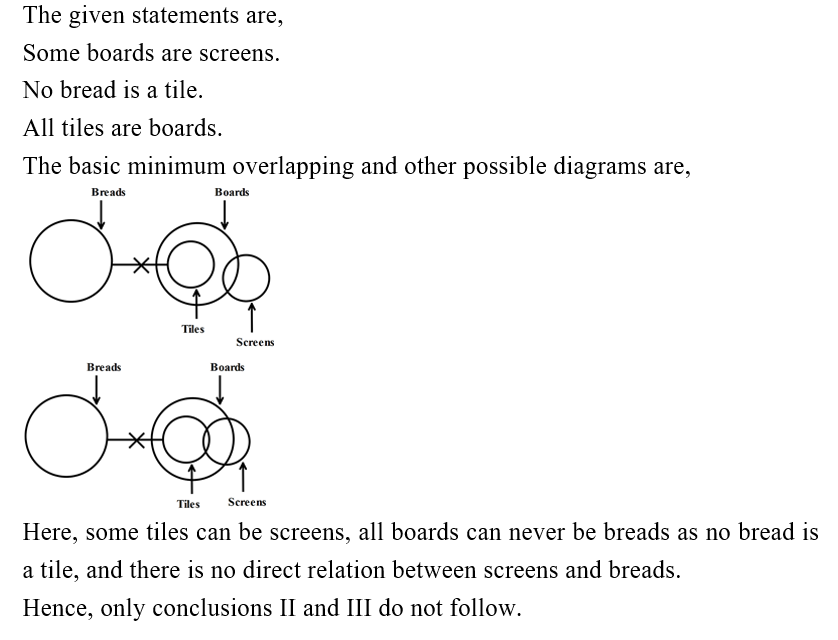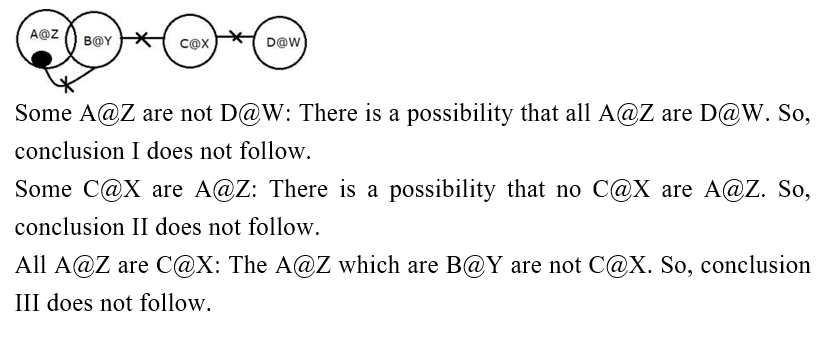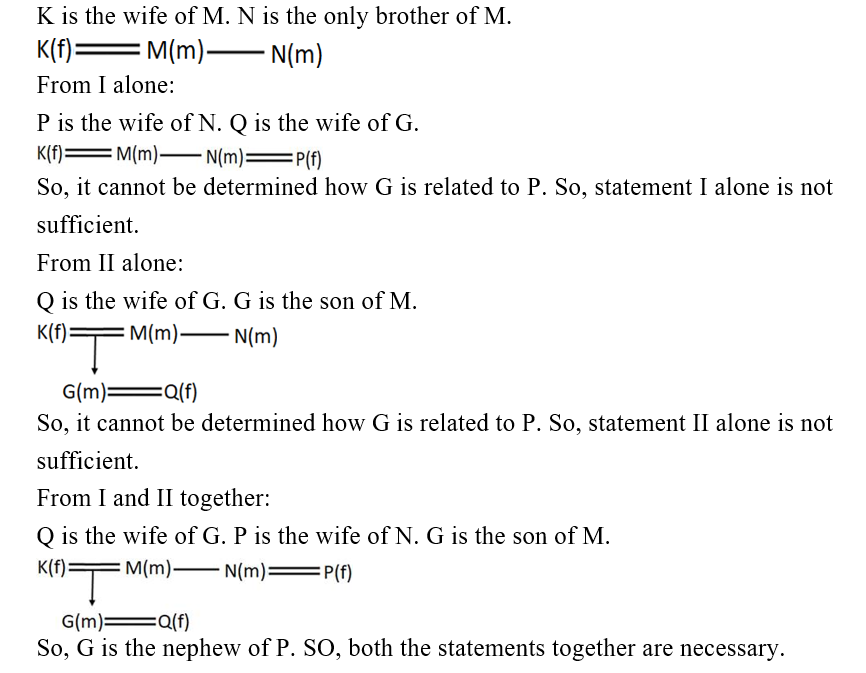Question 1:
In the following question, three statements are given, and two conclusions are given below these statements. Choose the option which shows the conclusions which logically follow from the given statements, disregarding commonly known facts.
निम्नलिखित प्रश्न में तीन कथन दिए गए हैं और इन कथनों के नीचे दो निष्कर्ष दिए गए हैं। उस विकल्प का चयन करें जो सामान्यतः ज्ञात तथ्यों की अवहेलना करते हुए दिए गए कथनों का तार्किक रूप से अनुसरण करने वाले निष्कर्षों को दर्शाता है।
Statements: All pans are plates.
कथन : सभी पैन, प्लेट हैं।
Only a few pans are bowls.
केवल कुछ पैन, बाउल हैं।
No bowls are forks.
कोई बाउल, फोर्क नहीं हैं।
Conclusions: I. All plates can never be forks.
निष्कर्ष : I. सभी प्लेट कभी भी फोर्क नहीं हो सकते हैं।
II. Some forks are pans.
II. कुछ फोर्क, पैन हैं।
Question 2:
In the following question, three statements are given and three conclusions are given below these statements. Choose the option which shows the conclusions which logically do not follow from the given statements, disregarding commonly known facts.
निम्नलिखित प्रश्न में तीन कथन और उनके नीचे तीन निष्कर्ष दिए गए हैं। उस विकल्प का चयन कीजिए जो उस/उन निष्कर्ष/निष्कर्षों को दर्शाता है जो आमतौर पर ज्ञात तथ्यों की अवहेलना करते हुए दिए गए कथनों का तार्किक रूप से अनुसरण नहीं करता/करते है/हैं।
Statements: Some boards are screens.
कथन : कुछ बोर्ड, स्क्रीन हैं
No bread is a tile.
कोई ब्रीड, टाइल नहीं है
All tiles are boards.
सभी टाइल्स, बोर्ड हैं
Conclusions: I. Some tiles can be screens.
निष्कर्ष : I. कुछ टाइल्स, स्क्रीन हो सकते हैं
II. All boards can be breads.
II. सभी बोर्ड, ब्रीड हो सकते हैं
III. All screens are breads.
III. सभी स्क्रीन,ब्रीड हैं
Question 3:
In the question given below, three statements are given followed by three conclusions. You have to take the given statements to be true even if they seem to be at variance from commonly known facts. Read the conclusions and decide which of the given conclusions logically follows from the given statements disregarding the commonly known facts.
नीचे दिए गए प्रश्न में तीन कथन और उसके बाद तीन निष्कर्ष दिए गए हैं। आपको दिए गए कथनों को सत्य मानना है, भले ही वे सर्वज्ञात तथ्यों से भिन्न प्रतीत हों। निष्कर्षों को पढ़िए और निर्धारित कीजिए कि दिए गए निष्कर्षों में से कौन-सा निष्कर्ष सामान्य रूप से ज्ञात तथ्यों की अवहेलना करते हुए दिए गए कथनों का तार्किक रूप से अनुसरण करता है।
Statements: Only a few A@Z are B@Y
कथन: केवल कुछ A@Z, B@Y हैं।
No B@Y is C@X
कोई B@Y, C@X नहीं है।
No C@X is D@W
कोई C@X, D@W नहीं है।
Conclusions: I. Some A@Z are not D@W
निष्कर्ष: I. कुछ A@Z, D@W नहीं हैं।
II. Some C@X are A@Z
II. कुछ C@X, A@Z हैं।
III. All A@Z are C@X
III. सभी A@Z, C@X हैं।
Question 4:
Two statements numbered I and II are given below. You have to decide whether the data provided in the statements are sufficient to answer the question.
नीचे दो कथन संख्यांकित I और II दिए गए हैं। आपको यह निर्धारित करना है कि कथनों में दी गई सूचना प्रश्न का उत्तर देने के लिए पर्याप्त है या नहीं।
K is the wife of M. N is the only brother of M. Q is the wife of G. How is G related to P?
K, M की पत्नी है। N, M का इकलौता भाई है। Q, G की पत्नी है। G, P से किस प्रकार संबंधित है?
Statement I. P is the wife of N.
कथन I. P, N की पत्नी है।
Statement II. G is the son of M.
कथन II. G, M का पुत्र है।
Question 5:
Directions : Study the following information and answer the given questions.
निर्दे]: निम्नलिखित जानकारी का अध्ययन करें और दिए गए प्रश्नों के उत्तर दें।
A is 15cm to the North of B, which is 45cm to the West of C. D is 5cm to the North of C. E is 15cm to the East of D. G is 45cm to the West of F. A is 15cm to the West of H. H is 5cm to the North of G.
A, B के उत्तर की ओर 15 सेमी है, जो C के पश्चिम की ओर 45 सेमी है। D, C के उत्तर में 5 सेमी है। E, D के पूर्व में 15 सेमी है। G, F के पश्चिम में 45 सेमी है। A, H के पश्चिम में 15 सेमी है। H, G के उत्तर में 5 सेमी है।
In which direction is D with respect to A?
D, A के संबंध में किस दिशा में है?
Question 6:
Directions : Study the following information and answer the given questions.
निर्देश: निम्नलिखित जानकारी का अध्ययन करें और दिए गए प्रश्नों के उत्तर दें।
A is 15cm to the North of B, which is 45cm to the West of C. D is 5cm to the North of C. E is 15cm to the East of D. G is 45cm to the West of F. A is 15cm to the West of H. H is 5cm to the North of G.
A, B के उत्तर की ओर 15 सेमी है, जो C के पश्चिम की ओर 45 सेमी है। D, C के उत्तर में 5 सेमी है। E, D के पूर्व में 15 सेमी है। G, F के पश्चिम में 45 सेमी है। A, H के पश्चिम में 15 सेमी है। H, G के उत्तर में 5 सेमी है।
In which direction is B with respect to G?
B, G के संबंध में किस दिशा में है?
Question 7:
Directions : Study the following information and answer the given questions.
निर्देश: निम्नलिखित जानकारी का अध्ययन करें और दिए गए प्रश्नों के उत्तर दें।
A is 15cm to the North of B, which is 45cm to the West of C. D is 5cm to the North of C. E is 15cm to the East of D. G is 45cm to the West of F. A is 15cm to the West of H. H is 5cm to the North of G.
A, B के उत्तर की ओर 15 सेमी है, जो C के पश्चिम की ओर 45 सेमी है। D, C के उत्तर में 5 सेमी है। E, D के पूर्व में 15 सेमी है। G, F के पश्चिम में 45 सेमी है। A, H के पश्चिम में 15 सेमी है। H, G के उत्तर में 5 सेमी है।
C is to the ______ of H.
C, H के ________ में है।
Question 8:
In the question below, a statement is followed by two conclusions based on the statement. Study the conclusions and select the correct option as the answer.
नीचे दिए गए प्रश्न में, एक कथन के बाद कथन के आधार पर दो निष्कर्ष दिए गए हैं। निष्कर्षों का अध्ययन करें और उत्तर के रूप में सही विकल्प का चयन करें।
Statement: P < O > Y = S ≥ C < L; Q = F ≥ Y
Conclusion I: Q > C
II: Q = C
Question 9:
In the following question relationships between different elements is shown in the statements. Mark the correct options based on which conclusion/ conclusions follows.
निम्नलिखित प्रश्न में विभिन्न तत्वों के बीच के संबंधों को कथन में दर्शाया गया है। उस सही विकल्प को चिह्नित कीजिए जिसके आधार पर निष्कर्ष निकाला/निकाले जाता/जाते है/हैं।
Statement: A < M, O ≤ X < B, Y > T
Conclusions:
I. A = O
II. Y < A
Question 10:
Directions : A certain number of people are sitting in a linear row and all are facing in the north direction. B sits second from one of the extreme ends of the row. There are five people sitting in between A and B. Four people are sitting in between A and E. C sits third to the right of E. Four people are sitting in between C and D. F sits second to the right of C. D sits second from one of the extreme ends of the row. B and E are not immediate neighbors of each other.
निर्देश : एक निश्चित संख्या में लोग एक रैखिक पंक्ति में बैठे हैं और सभी उत्तर दिशा की ओर मुखरित हैं। B पंक्ति के किसी एक चरम छोर से दूसरे स्थान पर बैठा है। A और B के बीच में पाँच व्यक्ति बैठे हैं। A और E के बीच में चार व्यक्ति बैठे हैं। C, E के दाईं ओर से तीसरे स्थान पर बैठा है। C और D के बीच में चार व्यक्ति बैठे हैं। F, C के दाईं ओर से दूसरे स्थान पर बैठा है। D पंक्ति के किसी एक चरम छोर से दूसरे स्थान पर बैठता है। B और E एक दूसरे के निकटस्थ पड़ोसी नहीं हैं।
How many people are sitting in the row?
पंक्ति में कितने व्यक्ति बैठे हैं?







